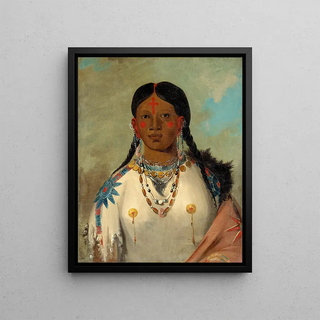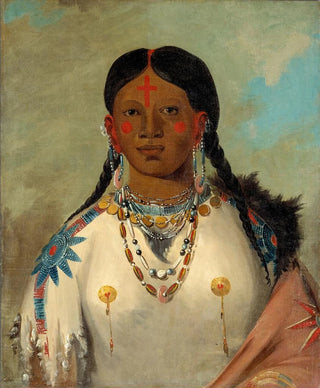Art print | TsSeWoNaTs The one who washes her knees, wife of the chief - George Catlin


View from behind

Frame (optional)
In the fascinating world of 19th-century American art, the "TsSeWoNaTs Woman Washing Her Knees, Wife of the Chief" by George Catlin stands out for its depth and authenticity. This painting, which captures an intimate moment in the life of a woman belonging to the Sioux tribe, offers a window into a often little-known culture and traditions that endure over time. Catlin, as a traveling artist, was able to immortalize not only scenes of daily life but also the spirit and soul of Indigenous peoples of America. The depiction of this woman, washing her knees, evokes simple beauty and serenity that invite the viewer to reflect on the relationship between man and nature, as well as on the rituals that punctuate the lives of Indigenous peoples.
Style and uniqueness of the work
Catlin's style is characterized by meticulous attention to detail and a vibrant color palette that breathes new life into his subjects. In "TsSeWoNaTs Woman Washing Her Knees, Wife of the Chief," the composition is carefully orchestrated, highlighting the central figure while skillfully integrating the natural elements surrounding her. The fluidity of lines and the play of light emphasize the delicacy of the moment depicted, creating an almost contemplative atmosphere. This art print stands out for its ability to transcend a simple portrait to become a true visual narrative, where each brushstroke tells a story. The posture of the woman, both humble and majestic, testifies to inner strength and dignity, often characteristic of Catlin's representations.
The artist and his influence
George Catlin, often considered the first artist to document Indigenous cultures, played a vital role in preserving the heritage of these peoples through his art. Born in 1796, he traveled across the United States to capture portraits, landscapes, and scenes of daily life of the tribes he encountered. His commitment to faithful representation of Indigenous cultures was motivated by deep admiration and a desire to raise awareness

Matte finish

View from behind

Frame (optional)
In the fascinating world of 19th-century American art, the "TsSeWoNaTs Woman Washing Her Knees, Wife of the Chief" by George Catlin stands out for its depth and authenticity. This painting, which captures an intimate moment in the life of a woman belonging to the Sioux tribe, offers a window into a often little-known culture and traditions that endure over time. Catlin, as a traveling artist, was able to immortalize not only scenes of daily life but also the spirit and soul of Indigenous peoples of America. The depiction of this woman, washing her knees, evokes simple beauty and serenity that invite the viewer to reflect on the relationship between man and nature, as well as on the rituals that punctuate the lives of Indigenous peoples.
Style and uniqueness of the work
Catlin's style is characterized by meticulous attention to detail and a vibrant color palette that breathes new life into his subjects. In "TsSeWoNaTs Woman Washing Her Knees, Wife of the Chief," the composition is carefully orchestrated, highlighting the central figure while skillfully integrating the natural elements surrounding her. The fluidity of lines and the play of light emphasize the delicacy of the moment depicted, creating an almost contemplative atmosphere. This art print stands out for its ability to transcend a simple portrait to become a true visual narrative, where each brushstroke tells a story. The posture of the woman, both humble and majestic, testifies to inner strength and dignity, often characteristic of Catlin's representations.
The artist and his influence
George Catlin, often considered the first artist to document Indigenous cultures, played a vital role in preserving the heritage of these peoples through his art. Born in 1796, he traveled across the United States to capture portraits, landscapes, and scenes of daily life of the tribes he encountered. His commitment to faithful representation of Indigenous cultures was motivated by deep admiration and a desire to raise awareness






